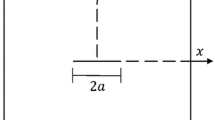Abstract
An effective numerical procedure for calculating stress intensity factors (SIF) in plane problems based on a modified boundary element technique not requiring any crack discretization was proposed by Snyder [1]. Instead of the usual fundamental solution, he used Green's function for the problem of a traction-free central crack in an anisotropic plate.
In the first part of the present paper, the corresponding Green's function for the isotropic problem, not explicitly included in [1], is presented. In addition to the central crack, a semi-infinite edge crack is considered. Both Green's functions are given for the case of the anti-plane state of strain as well. In the first step of the proposed procedure, the tractions and displacements along the outer boundary are calculated. In the second step, the SIF for modes I, II and III are derived in terms of simple boundary integrals over quantities known from the previous step. Contrary to Snyder's derivation, the determination of the SIF is based on the asymptotic displacement field at the crack tip. The method can easily be extended to multiple crack problems by using the subregion technique. Some illustrative examples demonstrate the effectiveness of the method.
Résumé
Snyder a proposé une procédure numérique pour le calcul des facteurs et intensité de contraintes dans les problèmes plans, en se basant sur une modification de la technique des éléments aux limites ne requérant pas de discrétisation de la fissure. Au lieu d'une solution fondamentale habituelle, il a utilisé une fonction de Green pour traiter le problème d'une fissure centrale libre de contraintes dans un plaque anisotrope.
Dans la première partie de la présente étude, on présente la fonction de Green qui correspond à un problème isotrope, qui n'était pas explicitement couvert par le travail de Snyder. Outre le cas de la fissure centrale, on considère le cas de la fissure de bord dans un milieu semi-infini. Les deux fonctions de Green relatives au cas d'un état de déformation antiplanaire sont également communiquées. Dans une première étape de la procédure proposée, on calcule les sollicitations et déplacements le long du contour extérieur; dans une deuxième étape, on établit les facteurs d'intensité de contraintes relatifs aux modes I, II et III en terms d'intégrals sur un contour simple défini par les valeurs résultant de l'étape précédente. Contraitement à l'approche de Snyder, on détermine le facteur d'intensité des contraintes sur base du champs de déplacement asymptotique à l'extrémité de la fissure. Par la technique des sous-régions, on peut aisément étendre la méthode à des problèmes de fissuration multiples. L'efficacité de la méthode est illustrée par divers exemples.
Similar content being viewed by others
References
M.D. Snyder, Crack Tip Stress-Intensity Factors in Finite Anisotropic Plates, Technical Report AFML-TR-73–209, Air Force Materials Laboratory, Ohio (1973).
G.C. Shih, Handbook of Stress-Intensity Factors, Institute of Fracture and Solid Mechanics, Lehigh University, Pennsylvania (1973).
R.S. Barsoum, International Journal of Numerical Methods in Engineering 11 (1977) 85–91.
H. Maschke, Technische Mechanik 6 (1985) 17–24.
S. Mukherjee and M. Morjaria, International Journal of Solids and Structures 17 (1981) 115–126.
D.J. Cartwright and T.P. Rich, in Proceedings of the First International Conference for Fracture Mechanics (Swansea) (1978) 550–568.
W.T. Ang, International Journal of Fracture 31 (1986) 259–270.
G. Kuhn, Zeitschrift für angewandte Mathematik und Mechanik 61 (1981) T105-T106.
W.W. Panasiuk, M.P. Savruk and A.P. Datsyshin, Stress Distribution Around Cracks in Plates and Shells, Naukova Dumka, Kiev (1976).
A.H. England, Complex Variable Methods in Elasticity, John Wiley and Sons Ltd., London (1971).
F. Erdogan, in Proceedings of the Fourth US National Congress of Applied Mechanics (1962) 547–553.
T.A. Cruse, in Recent Advantages in Boundary Element Method, Pentech Press, London (1978) 167–184.
H.W. Westergaard, Journal of Applied Mechanics 6 (1939) 49–53.
H. Mews, Berechnung von Spannungsintensitätsfaktoren mittels der Boundary-Element-Methode unter Verwendung von Greenschen Funktionen (Dissertation), Erlangen (1988).
P.C. Paris and H. Tada, International Journal of Fracture 11 (1975) 1070–1072.
Y. Murakami, Stress Intensity Factors Handbook, Pergamon Press, Oxford (1987).
G. Karami and R.T. Fenner, International Journal of Fracture 30 (1986) 13–29.
Author information
Authors and Affiliations
Rights and permissions
About this article
Cite this article
Mews, H., Kuhn, G. An effective numerical stress intensity factor calculation with no crack discretization. Int J Fract 38, 61–76 (1988). https://doi.org/10.1007/BF00034276
Received:
Accepted:
Published:
Issue Date:
DOI: https://doi.org/10.1007/BF00034276




